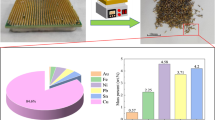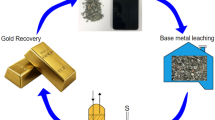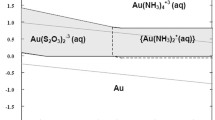Abstract
The importance of gold recycling from waste electronic and electrical equipment (WEEE) is continuously increasing due to raising gold demand and the need for new recycling methods for this complex waste. In state-of-the art processes gold is recovered in the copper route. In necessary pre-treatment steps, a significant loss of gold occurs. Furthermore, in this process the gold is bound for a longer time period in a copper phase and is separated in a mixture with other noble metals, which needs further treatment. A direct gold extraction from WEEE by selective leaching and precipitation would have many advantages. Due to raising social awareness of the ecological impacts of cyanidic gold extraction and environmental specifications, cyanide cannot be used as gold extractant in modern processes. Therefore, over the course of this study, two experimental sets have been conducted on each of six non-cyanide leaching reagents to test their feasibility and compare them against each other. Aqua regia and iodine/iodide leaching systems were the most successful reagents, yielding 100% of gold while showing very fast leaching rates. A comparison between the two successful reagents was carried out, with the results favoring iodine leaching due to its high selectivity for precious metals and reduced environmental impact.

Data from 2015 are forecast [1] (color figure online)







Similar content being viewed by others
References
Baldé C et al (2015) The global E-waste monitor—2014. United Nations University, Bonn
Akcil A et al (2015) Precious metal recovery from waste printed circuit boards using cyanide and non-cyanide lixiviants—a review. Waste Manag 45:258–271
Zhang L, Xu Z (2016) A review of current progress of recycling technologies for metals from waste electrical and electronic equipment. J Clean Prod 127:19–36
Tuncuk A et al (2011) Aqueous metal recovery techniques from E-scrap: hydrometallurgy in recycling. Miner Eng 25(1):28–37
Kasper et al (2015) Electronic waste: recycling techniques (Chapter 9). Springer, Cham
Norgate T, Haque N (2012) Using life cycle assessment to evaluate some environmental impacts of gold production. Elsevier 29–30:53–63
Montero R et al (2012) Recovery of gold, silver, copper and niobium from printed circuit boards using leaching column technique. J Earth Sci Eng 2:590–595
Silver Processing, Encyclopedia Britannica. https://www.britannica.com/technology/silver-processing. Accessed 11 Aug 2016
Environmental Protection Agency (EPA) (2010) Toxicological review of hydrogen cyanide and cyanide salts
Mineral Commodity Summaries (2012) Gold production in world, George US Geological Survey
Marsden K, House I (2006) The chemistry of gold extraction. SME, Littleton
Syed S (2012) Recovery of gold from secondary sources: a review. Hydrometallurgy 115–116:30–51
Zhang Y et al (2012) Current status on leaching precious metals from waste printed circuit boards. Procedia Environ Sci 16:560–568
Park Y, Fray D (2009) Recovery of high purity precious metals from printed circuit boards. J Hazard Mater 164:1152–1158
Sheng P, Etsell T (2007) Recovery of gold from computer circuit board scrap using aqua regia. Waste Manag Res 25:380–383
Sahin M et al (2015) A potential alternative for precious metal recovery from E-waste: iodine leaching 50:2587–2595
Baghalha M (2012) The leaching kinetics of an oxide gold ore with iodide/iodine solutions. Hydrometallurgy 113–114:42–50
Chen L et al (2009) Iodine leaching process for recovery of gold from waste PCB. Chin J Environ Eng 3:911–914
Wang H et al (2013) Study on gold concentrate leaching by iodine-iodide. Int J Miner Metall Mater 20:323–328
Melashvili M, Manimaran M (2014) Study of gold leaching with bromine and bromide and the influence of suphide minders on this reaction. In: Conference of metallurgists proceedings 2014
Tripathi A et al (2012) Leaching of gold from the waste mobile phone printed circuit boards (PCBs) with ammonium thiosulfate. Int J Metall Eng 1:17–21
Ying L, Li X (2011) Thiosulfate leaching of gold and silver from waste mobile phones. In: International conference on bioinformatics and biomedical engineering 2011
Li J, Miller D (2007) Reaction kinetics of gold dissolution in acid thiourea solution using ferric sulfate as oxidant. Hydrometallurgy 89:279–288
Huyhua J et al (1989) A comparative study of oxidants on gold and silver dissolution in acidic thiourea solutions. In: Proceedings of the Minerals, Metals and Materials Society, 1989
Zhang W et al (2016) Mechanism and clean procedure to extract gold from printed circuit board. Procedia Environ Sci 31:171–177
Wu J et al (2009) Gold and silver selective leaching from printed circuit boards scrap with acid thiourea solution. Nonferrous Metals 61:90–93
Zhong F et al (2006) Experimental study on leaching gold in printed circuit boards scrap with thiourea. Non-Ferrous Metals Recycl Util 6:25–27
Wu J et al (2008) Study on selectively leaching gold from waste printed circuit boards with thiourea. Chin J Gold 6:55–58
Gernon M (1996) Preparation of a precious metal salt of a non-oxidizing acid by direct reaction. European Patent Application, EP0711753A1
Gernon M et al (1999) Environmental benefits of methanesulfonic acid: comparative properties and advantages. Green Chem 1:127–140
Zhang J, Lan Z (1992) Leaching gold and silver by the LSSS method—Part I. synthesizing the LSSS and dissolving Au and Ag. In: International Conference-Proceeding Precious Metals, 1992
Zhao L et al (2015) Effects of lime sulfur synthetic solution on leaching characteristic of gold concentrates. Chin J Nonferrous Met 25:786–792
Ying L, Lu H (2010) The leaching of gold and silver from E-waste by LSSS method. Waste Manag 32:1209–1212
Aylmore M, Muir D (2001) Thiosulfate leaching of gold—a review. Miner Eng 14:135–174
Author information
Authors and Affiliations
Corresponding author
Additional information
The contributing editor for this article was D. Panias.
Rights and permissions
About this article
Cite this article
Birich, A., Raslan Mohamed, S. & Friedrich, B. Screening of Non-cyanide Leaching Reagents for Gold Recovery from Waste Electric and Electronic Equipment. J. Sustain. Metall. 4, 265–275 (2018). https://doi.org/10.1007/s40831-018-0160-x
Published:
Issue Date:
DOI: https://doi.org/10.1007/s40831-018-0160-x




